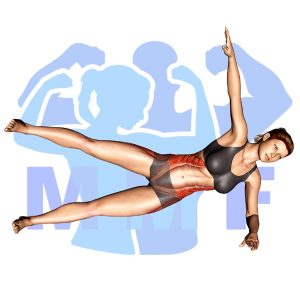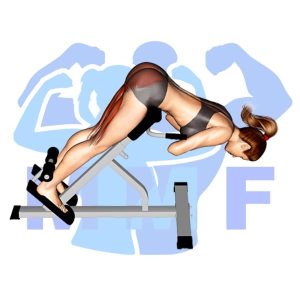Are you tired of endless crunches with no visible results on your obliques? Are you struggling to tone and strengthen those stubborn muscles at your waistline? Don’t worry, you’re not alone. Many people struggle to target their obliques effectively, despite putting in countless hours at the gym. The cause of this problem is often a lack of understanding and proper technique. But fear not, the solution is simple – the oblique crunch. In this post, we will break down the correct form and benefits of this exercise to help you achieve the toned midsection you’ve been working towards.
Oblique Crunch Summary
- Primary Muscles: Obliques
- Secondary Muscles: Quadratus lumborum, Psoas major, Iliocastalis lumborum, and Iliocastalis thoracis
- Equipment: Body Weight
- Mechanics Type: Isolated
- Force: Pull
- Utility: Auxiliary

Oblique Crunch Instructions
- Setup by laying on your back on a mat with one knee bent and the other leg crossed with your ankle on your bent knee.
- Place your hands behind your neck or head. Flex and twist your core to raise your upper torso from the mat to one side.
- Return until the back of your shoulders contact mat.
- Repeat these crunches for a complete set with one side. Then switch your leg positions and complete another set.
Video Tutorial
Oblique Crunch Muscles
Target (Agonist)
Synergists
- Quadratus lumborum
- Psoas major
- Iliocastalis lumborum
- Iliocastalis thoracis
Dynamic Stabilizers
- None
Stabilizers
- No Significant Stabilizers
Antagonist Stabilizers
- None

Benefits of Oblique Crunch
The oblique crunch is an effective exercise for strengthening the obliques, the abdominal muscles that wrap around the sides of the torso. This exercise helps to develop a more toned and defined waistline, as well as improved posture and balance. Additionally, the oblique crunch works to stabilize the spine, helping to reduce pain and fatigue associated with lower back issues. Furthermore, this exercise is a great way to target the obliques without putting unnecessary strain on the lower back. By performing this exercise regularly, you can help improve your core strength, overall balance, and stability.
Tips for Performing Oblique Crunch
You’ve come to the right place if you’re trying to enhance your oblique crunch performance. Using these tips can allow you to take full advantage of this beautiful workout. Concurrently with shaping your obliques muscles, increasing movability, and even a reduced possibility of injury can all be accomplished with this exercise. Let’s begin and take a look at how these tips will help you.
- Ensure your form is correct: Sit up straight, keep your neck in line with your spine and make sure your shoulder blades are off the floor for maximum benefit. Doing the oblique crunch correctly will help you to target the right muscles and prevent injury.
- Keep your movement slow and controlled: Move slowly and pause at the top of the crunch to engage the muscles and avoid jerking motions that can cause injury. This also helps to ensure that you are targeting the correct muscles.
- Monitor your progress: Keep track of how many reps you do each session, as well as how long you hold the crunch at the top. As your fitness levels improve, you can increase the intensity of the exercise and challenge yourself further.
Benefits and Tips Video
Frequent Mistakes To Avoid
Staying away from errors might mean the distinction between a productive workout and an injury when executing oblique crunch. Moreover, achieving optimal results from this exercise requires proper form, and making sure you don’t perform typical errors can allow you to perform the exercise better and obtain your desired results. But relax, it’s not as challenging as it might seem. By knowing the errors to avoid and taking the right actions, you may complete the activity securely and effectively. Thus, it is now your turn to maximize your results from this exercise and enjoy the benefits of a successful workout.
- Not engaging the core muscles: Many people forget to engage their core muscles when doing the oblique crunch, which is detrimental to the effectiveness of the exercise and can lead to poor posture and even injury.
- Not performing a full range of motion: Doing the oblique crunch with a shallow range of motion reduces its efficiency and limits the effectiveness of the exercise. It is important to perform the movement fully and with control to get the best results.
- Not using proper form: Proper form is essential when performing any exercise, and the oblique crunch is no different. Not using proper form can lead to ineffective workouts and can even cause injury. It is important to practice proper form and technique to maximize results.
Find More Bodyweight Exercises Here
Variations and Complementary Exercises
The Oblique Crunch is a great exercise for strengthening the obliques and core, but it’s not the only one. Below are some variations, complementary, and alternative exercises that can provide similar benefits:
Legs Up Twist Crunch

Legs Up Twist Crunch is a great complement or alternative to the Oblique Crunch exercise. This exercise works the entire abdominal area by twisting the torso and legs in opposite directions. It is a great way to target the sides of the abs, as well as the core muscles. The legs are lifted and twisted while the arms are held straight out in front of you. As you twist the torso, crunch your abdominals and hold the contraction for a moment before returning to the starting position. Legs Up Twist Crunch can be a great way to mix up your ab routine, providing a challenging and effective alternative to Oblique Crunch.
Bicycle Twist Crunch

The Bicycle Twist Crunch is an excellent complementary or alternative exercise for the Oblique Crunch. It works the same core muscles as the Oblique Crunch but with a twist. The Bicycle Twist Crunch engages the abdominal muscles, obliques, and hip flexors while also incorporating a slight rotation of the torso. This twisting motion adds an extra challenge and helps to target the oblique muscles in a different way than the traditional Oblique Crunch. In addition, this exercise can be done with or without weights, making it perfect for both beginner and advanced exercisers.
Twist Crunch

Twist Crunch is an excellent complementary or alternative exercise for Oblique Crunch. The movement of the Twist Crunch targets the obliques and external obliques as well as the lower abdominals. This exercise helps to strengthen and tone these areas. The added twist also works the hips, glutes and lower back muscles, giving it an overall core strengthening effect. It is a great way to add variety to your ab routine and challenge your core in different ways.
Check Out These Top Bodyweight Exercises
Star Plank

Star Plank is an excellent alternative or complementary exercise to the oblique crunch. This exercise engages the entire core, while still targeting the side muscles. It requires the user to hold a plank position while lifting one arm and the opposite leg off the ground. This exercise activates multiple muscle groups at the same time, while still providing the same benefits as the oblique crunch, such as strengthening and toning the abdominal muscles. The Star Plank is an effective exercise for building core strength and stability, which can help improve posture, reduce back pain and make everyday activities easier.
Side Plank Star Abductor

Side Plank Star Abductor is an excellent alternative or complementary exercise to the Oblique Crunch. This exercise involves getting into a side plank position and then extending the top leg out to the side as far as possible. This exercise engages the obliques, but also works the glutes, quads, and hip abductors. It also helps to strengthen the stabilizing muscles in the core, which can help improve balance and coordination.
Side Plank Leg Raise

The Side Plank Leg Raise is an excellent complementary or alternative exercise to the Oblique Crunch. This exercise targets the obliques while also engaging the abs, glutes, and hip flexors. To do this exercise, start in a side plank position, then lift the top leg up towards the ceiling and back down. This exercise can be made more challenging by adding a weight to the top leg or by doing a reverse version of the move by bringing the bottom leg up. The Side Plank Leg Raise is an effective way to target the core muscles and build strength in the obliques.
Find More Abs Exercises Here
Opposing Complementary Exercises
The Oblique Crunch is a great exercise to target the oblique muscles. However, to ensure overall muscle balance and injury prevention, it’s important to do exercises that work the opposing muscles as well. Here are some exercises that complement the Oblique Crunch by targeting the opposing muscles:
45 Degree Hyperextension

The 45 degree hyperextension is a great exercise for targeting the lower back muscles, which is the opposing muscle group to the oblique crunch. This exercise works to strengthen and tone the muscles in the lower back and glutes, providing balance to the oblique crunch. By working the opposite muscle group to the oblique crunch, you can ensure that your body is getting a well-rounded core workout and achieving symmetry. The 45 degree hyperextension is an effective exercise for strengthening and toning your lower back muscles, helping to complement the oblique crunch.
Straight Leg Cable Pull Through

The Straight Leg Cable Pull Through is a great complementary exercise to the Oblique Crunch as it targets the opposing muscle group. This exercise works the posterior chain, including the glutes and hamstrings, and requires you to keep your legs straight while pulling the cable from behind your body. This helps to build strength and stability in the posterior chain, which is essential for maintaining good posture and balance during the Oblique Crunch. By incorporating both exercises into your routine, you can help to ensure that all of the muscles in your core are working together to create a balanced and effective workout.
Bird Dog Plank

Bird Dog Plank is an excellent complementary exercise to Oblique Crunch because it targets the opposing muscle group. The Bird Dog Plank works the upper body, specifically the back and shoulders, while the Oblique Crunch works the abdominal muscles. Bird Dog Plank requires the participant to hold a plank position while alternating lifting opposite arms and legs. This strengthens the core and helps to improve balance, posture, and stability. By targeting the opposing muscle groups, both exercises can be used together to help build a stronger, more balanced physique.
Get Shredded Abs With Oblique Crunch!
Want to add some serious definition to your abs? Look no further than the oblique crunch! This exercise targets the often-overlooked oblique muscles, which can help create those coveted “shredded” abs. Incorporating oblique crunches into your routine can also help with overall core strength and stability. Plus, who doesn’t want to add a little extra curve to their waistline? So, next time you hit the gym, be sure to give oblique crunches a try for a killer core workout.
References: Wikipedia | ExRx.net | PubMed.gov | Comprehensive List of Abs Bodyweight Exercises

